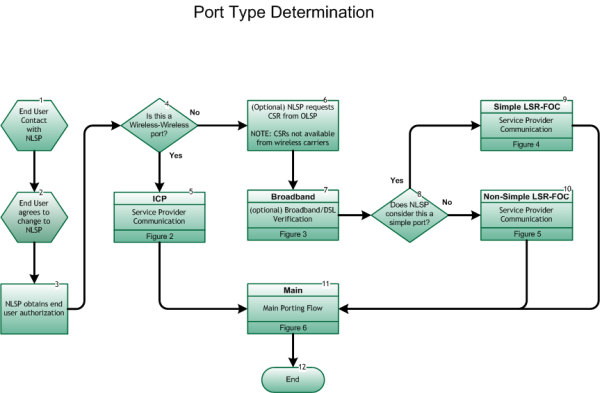Step 1: START: End User Contact with NLSP
- The process begins with an end user requesting service from the NLSP.
- It is assumed that prior to entering the provisioning process the involved NPA/NXX was opened for porting (If code is not open, refer to Inter-Service Provider LNP Operations Flows – Code Opening Process, Figure 16
.).
Step 2: End User agrees to change to NLSP
- End user agrees to change to NLSP and requests retention of current telephone number (TN).
Step 3: NLSP obtains end user authorization
- NLSP obtains verifiable authority (e.g., Letter of Authorization – [LOA], third-party verification – [TPV], etc.) from end user to act as the official agent on behalf of the end user. The OLSP cannot require a physical copy of the end user authorization to be provided before processing the Customer Service Request (CSR) or the port request. The NLSP is responsible for demonstrating verifiable authority in the case of a dispute.
Step 4: Is this a Wireless-Wireless Port?
- If Yes, go to Step 5.
- If No, go to Step 6.
Step 5: ICP – Service Provider Communication
Step 6: (Optional) NLSP requests CSR from OLSP
- As an optional step, the NLSP requests a Customer Service Record (CSR) from the OLSP. A service agreement between the NLSP and OLSP may or may not be required for CSR. NOTE: CSRs are not available from wireless carriers.
- The Old SP shall not require the New SP to have previously obtained a CSR before they will accept an LSR from the New SP. For those New SPs that choose not to obtain a CSR, they understand that there is heightened risk that their LSR may not be complete and accurate. This is not intended to preclude those providers who provide an ordering GUI from including a step involving a real-time CSR pull within that process, as long as an alternate ordering process is available that does not require a CSR being pulled.
- CSRs, if requested and available, must be returned within 24 clock hours, unless otherwise negotiated between service providers, excluding weekends and Old Service Provider holidays.
- Any of the end user validation fields required by the Old SP on an incoming LSR must be available on the CSR, excluding end user requested and assigned password/PIN.
- Only passwords/PINs requested and assigned by the end user may be utilized as an end user validation field on an incoming LSR by the Old Network Service Provider/Old Local Service Provider. Any service provider assigned password/PIN may not be utilized as a requirement in order to obtain a CSR.
Step 7: BROADBAND – (optional) Broadband/DSL Verification
Step 8: Does NLSP consider this a Simple Port?
- If Yes, go to Step 9.
- The New SP (the NLSP and/or the NNSP whichever is applicable) must make every reasonable effort to verify that the port request is in fact a Simple Port request, e.g., pulling a CSR if available, or asking the appropriate questions of the end user, etc.
- If No, go to Step 10.
Step 9: SIMPLE LSR-FOC – Service Provider Communication
Step 10: NON-SIMPLE LSR-FOC – Service Provider Communication
Step 11: MAIN – Main Porting Flow
END

